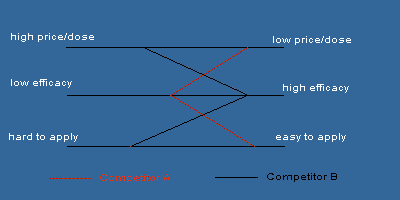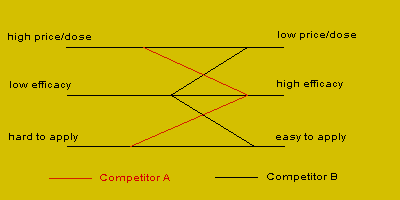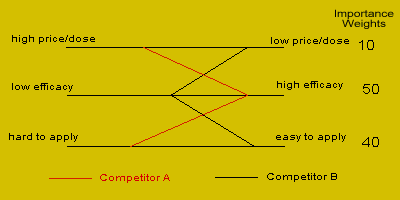There is a tendency in marketing to think mostly about what customers care about. That is, what benefits customers really want.
But there is another important part that should be deeply appreciated by anyone who markets products, and that is customer perceptions, or how customers view (or perceive) the different products on the market. One technique that clearly depicts these customer perceptions is "snake-plot". It is a technique that falls under the umbrella term of "perceptual mapping."
The concept of a snake plot is simple. We first gather the benefits that customers use to judge the different products on the market. You can see a tutorial if you are unclear about these terms: Benefits vs. Attributes. Then place each benefit on a scale with the appropriate endpoints. Conceptually, we might think of this as a simple 5 or 7 point scale. An example is shown below for three benefits that might be applied to a pharmaceutical drug: efficacy (how effective it is), price/dose, and ease of application.
Notice that the so-called better things (like low price) are on the right hand side which aids in interpretation. The points where the red and black lines intersect the various benefit lines represent customer's perceptions of the products from Competitor A and B.
In this example, the product of Competitor A is perceived as relatively low in efficacy compared to the product of Competitor B. But, the price per dose of Competitor A's product is perceived as lower. Finally, Competitor A's product is perceived as relatively easier to apply than Competitor B's product. The difference between customer's perceptions of the two products represents a perceptual gap. Obviously you'd like the perceptual gap to be in your favor.

A number of of things to note about this snake-plot. First, not all customers will have the exact same perceptions, thus the intersecting points represent the average perceptions in the market. Second, one might think of the upper end of each benefit (i.e., the maximum perception) as nirvana, and rarely if ever do customers perceive a product's benefit like
that. The lower end might be thought of as pathologically bad (again, rare but certainly possible). Third, the exact point of the perception of a product is not as important as the relative distance between the perceptions of the various products. Finally, one might ask how we get data for this map. In fact, there are several ways to do this with real data and you will can learn this in another we tutorial will write shrotly. But for now, just think of this as a reasonable way to think about customer perceptions.
Now, take the same benefits and imagine a different situation. Here the two products of the competitors are switched around, and so the problems facing Competitor A are quite different than before.

But if Competitor A were to compete successfully with Competitor B, how could it do this now given the obvious problems with ease of application and its relatively higher price. You could try to lower price or you could look for ways to make the drug easier to apply. But which action would be best?
The answer lies in first understanding that this map does not currently indicate customer preferences. Assuming that we have previously segmented the market (see the tutorial on segmentation), we can fill out the snake plot with customer preferences in the segment we are considering. The result, below, is a so-called "joint space map" because we have a picture of both perceptions and preferences.

Now we have a clearer idea of what we might do. Clearly this segment cares mostly about the cluster of benefits including efficacy and ease of application far more than low price. Lowering price for this segment would not be as important as increasing the ease of application.
So how do you close the gap for the benefits that customers in the segment care about? Basically there are four ways.
- Change perceptions of your product. This will require changing features and concrete attributes that affect the relevant benefit and then communicating that to the market.
- Change perceptions of your competitor's product. This is difficult to do, but possible. Actively advertising your competitor's product is often illegal, and even when it is legal, this tactic must be done judiciously in order to avoid backlash and legitimizing a competitor's product.
- Change customer preferences. Again, this is difficult but possible. If customer's care deeply about certain benefits, it is wasteful and costly to spend energy trying to change them. Better to give them what they want.
- Find new benefits. Of course, assuming that you've done due diligence in identify what customer's care about, this is not a viable option.
There are other ways to graphically analyze customer perceptions, including the well know method of multidimensional scaling. I will be writing a tutorial on this later on, but the insights are similar to that of a snake-plot (and often I find the snake-plot more useful).
With perceptions and preferences understood, and assuming we've segmented the market correctly, we are ready to examine the next aspect of marketing analysis, namely competitor analysis.
The reason for the necessity of competitor analysis is clearly indicated by the snake plot. If you choose to increase a benefit a customer segment cares about, chances are your competitor may do the same thing. Before we make a mistake and spend resources entering a segment or increasing benefits, etc., good competitive analysis is necessary.




